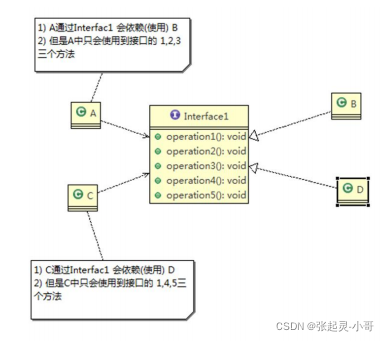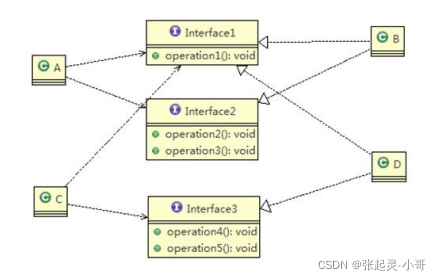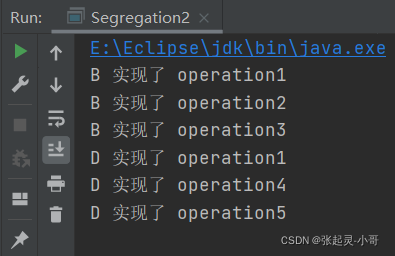жӮЁеҘҪпјҢзҷ»еҪ•еҗҺжүҚиғҪдёӢи®ўеҚ•е“ҰпјҒ
е°Ҹзј–з»ҷеӨ§е®¶еҲҶдә«дёҖдёӢJavaдёӯжҺҘеҸЈйҡ”зҰ»еҺҹеҲҷжҳҜд»Җд№ҲпјҢзӣёдҝЎеӨ§йғЁеҲҶдәәйғҪиҝҳдёҚжҖҺд№ҲдәҶи§ЈпјҢеӣ жӯӨеҲҶдә«иҝҷзҜҮж–Үз« з»ҷеӨ§е®¶еҸӮиҖғдёҖдёӢпјҢеёҢжңӣеӨ§е®¶йҳ…иҜ»е®ҢиҝҷзҜҮж–Үз« еҗҺеӨ§жңү收иҺ·пјҢдёӢйқўи®©жҲ‘们дёҖиө·еҺ»дәҶи§ЈдёҖдёӢеҗ§пјҒ
е®ўжҲ·з«ҜдёҚеә”иҜҘдҫқиө–е®ғдёҚйңҖиҰҒзҡ„жҺҘеҸЈпјҢеҚідёҖдёӘзұ»еҜ№еҸҰдёҖдёӘзұ»зҡ„дҫқиө–еә”иҜҘе»әз«ӢеңЁжңҖе°Ҹзҡ„жҺҘеҸЈиҢғеӣҙдёҠгҖӮ

дёҠйқўиҝҷеј еӣҫе‘ўпјҢе°ұиҝқеҸҚдәҶжҺҘеҸЈйҡ”зҰ»еҺҹеҲҷгҖӮе®ғеҜ№еә”зҡ„д»Јз ҒеҰӮдёӢпјҡ????????????
package com.szh.principle.segregation;
/**
*
*/
interface Interface1 {
void operation1();
void operation2();
void operation3();
void operation4();
void operation5();
}
class B implements Interface1 {
public void operation1() {
System.out.println("B е®һзҺ°дәҶ operation1");
}
public void operation2() {
System.out.println("B е®һзҺ°дәҶ operation2");
}
public void operation3() {
System.out.println("B е®һзҺ°дәҶ operation3");
}
public void operation4() {
System.out.println("B е®һзҺ°дәҶ operation4");
}
public void operation5() {
System.out.println("B е®һзҺ°дәҶ operation5");
}
}
class D implements Interface1 {
public void operation1() {
System.out.println("D е®һзҺ°дәҶ operation1");
}
public void operation2() {
System.out.println("D е®һзҺ°дәҶ operation2");
}
public void operation3() {
System.out.println("D е®һзҺ°дәҶ operation3");
}
public void operation4() {
System.out.println("D е®һзҺ°дәҶ operation4");
}
public void operation5() {
System.out.println("D е®һзҺ°дәҶ operation5");
}
}
class A { //A зұ»йҖҡиҝҮжҺҘеҸЈInterface1 дҫқиө–(дҪҝз”Ё) Bзұ»пјҢдҪҶжҳҜеҸӘдјҡз”ЁеҲ°1,2,3ж–№жі•
public void depend1(Interface1 i) {
i.operation1();
}
public void depend2(Interface1 i) {
i.operation2();
}
public void depend3(Interface1 i) {
i.operation3();
}
}
class C { //C зұ»йҖҡиҝҮжҺҘеҸЈInterface1 дҫқиө–(дҪҝз”Ё) Dзұ»пјҢдҪҶжҳҜеҸӘдјҡз”ЁеҲ°1,4,5ж–№жі•
public void depend1(Interface1 i) {
i.operation1();
}
public void depend4(Interface1 i) {
i.operation4();
}
public void depend5(Interface1 i) {
i.operation5();
}
}
public class Segregation1 {
public static void main(String[] args) {
A a = new A();
a.depend1(new B()); // Aзұ»йҖҡиҝҮжҺҘеҸЈеҺ»дҫқиө–Bзұ»
a.depend2(new B());
a.depend3(new B());
C c = new C();
c.depend1(new D()); // Cзұ»йҖҡиҝҮжҺҘеҸЈеҺ»дҫқиө–(дҪҝз”Ё)Dзұ»
c.depend4(new D());
c.depend5(new D());
}
}д»Јз ҒиҷҪ然еҫҲй•ҝпјҢдҪҶжҳҜдёҚйҡҫзҗҶи§ЈгҖӮAзұ»дҫқиө–дәҶBзұ»пјҢдҪҶжҳҜеҸӘдјҡз”ЁеҲ°йЎ¶зә§жҺҘеҸЈдёӯзҡ„1гҖҒ2гҖҒ3иҝҷдёүдёӘж–№жі•пјӣиҖҢCзұ»дҫқиө–дәҶDзұ»пјҢдҪҶжҳҜеҸӘдјҡз”ЁеҲ°йЎ¶зә§жҺҘеҸЈдёӯзҡ„1гҖҒ4гҖҒ5иҝҷдёүдёӘж–№жі•пјҢд№ҹе°ұжҳҜиҜҙеңЁAе’ҢBиҝҷдёӨдёӘзұ»зҡ„еұӮйқўдёҠиҖҢиЁҖпјҢе’ҢйЎ¶зә§жҺҘеҸЈдёӯзҡ„4гҖҒ5дёӨдёӘж–№жі•жҳҜжІЎд»Җд№Ҳе…іиҒ”зҡ„пјҢйӮЈд№ҲBзұ»еңЁе®һзҺ°йЎ¶зә§жҺҘеҸЈзҡ„ж—¶еҖҷе°ұжІЎеҝ…иҰҒйҮҚеҶҷ4гҖҒ5иҝҷдёӨдёӘж–№жі•дәҶгҖӮдҪҶжҳҜиҝҷйҮҢжңүдёҖдёӘй—®йўҳе°ұжҳҜйЎ¶зә§жҺҘеҸЈдёӯеҢ…жӢ¬дәҶ1еҲ°5иҝҷдә”дёӘж–№жі•пјҢдҪ еҰӮжһңе®һзҺ°иҝҷдёӘжҺҘеҸЈе°ұеҝ…йЎ»йҮҚеҶҷиҝҷдә”дёӘж–№жі•пјҢйӮЈд№ҲжҲ‘们е°ұеҸҜд»ҘиҖғиҷ‘е°ҶйЎ¶зә§жҺҘеҸЈжӢҶеҲҶжҲҗеӨҡдёӘжҺҘеҸЈпјҢйңҖиҰҒз”ЁеҲ°е“ӘдёӘе°ұе®һзҺ°е“ӘдёӘпјҢиҝҷд№ҹе°ұжҳҜжүҖи°“зҡ„жҺҘеҸЈйҡ”зҰ»дәҶгҖӮ

з»ҸиҝҮдёҠйқўзҡ„дёҖз•ӘеҸҷиҝ°пјҢжҲ‘们еҸҜд»Ҙе°Ҷд»Јз Ғж”№еҶҷжҲҗдёӢйқўзҡ„еҪўејҸгҖӮ
еҚіе°ҶйЎ¶зә§жҺҘеҸЈжӢҶеҲҶжҲҗ3дёӘе°ҸжҺҘеҸЈпјҢBгҖҒDдёӨдёӘзұ»ж №жҚ®е®һйҷ…жғ…еҶөиҜҘе®һзҺ°е“ӘдёӘжҺҘеҸЈе°ұе®һзҺ°е“ӘдёӘжҺҘеҸЈпјҲеӣ дёәиҝҷдә”дёӘж–№жі•е·Із»Ҹиў«еҲҶејҖдәҶпјүгҖӮ
package com.szh.principle.segregation.improve;
/**
*
*/
interface Interface1 {
void operation1();
}
interface Interface2 {
void operation2();
void operation3();
}
interface Interface3 {
void operation4();
void operation5();
}
class B implements Interface1, Interface2 {
public void operation1() {
System.out.println("B е®һзҺ°дәҶ operation1");
}
public void operation2() {
System.out.println("B е®һзҺ°дәҶ operation2");
}
public void operation3() {
System.out.println("B е®һзҺ°дәҶ operation3");
}
}
class D implements Interface1, Interface3 {
public void operation1() {
System.out.println("D е®һзҺ°дәҶ operation1");
}
public void operation4() {
System.out.println("D е®һзҺ°дәҶ operation4");
}
public void operation5() {
System.out.println("D е®һзҺ°дәҶ operation5");
}
}
class A { // A зұ»йҖҡиҝҮжҺҘеҸЈInterface1,Interface2 дҫқиө–(дҪҝз”Ё) Bзұ»пјҢдҪҶжҳҜеҸӘдјҡз”ЁеҲ°1,2,3ж–№жі•
public void depend1(Interface1 i) {
i.operation1();
}
public void depend2(Interface2 i) {
i.operation2();
}
public void depend3(Interface2 i) {
i.operation3();
}
}
class C { // C зұ»йҖҡиҝҮжҺҘеҸЈInterface1,Interface3 дҫқиө–(дҪҝз”Ё) Dзұ»пјҢдҪҶжҳҜеҸӘдјҡз”ЁеҲ°1,4,5ж–№жі•
public void depend1(Interface1 i) {
i.operation1();
}
public void depend4(Interface3 i) {
i.operation4();
}
public void depend5(Interface3 i) {
i.operation5();
}
}
public class Segregation2 {
public static void main(String[] args) {
A a = new A();
a.depend1(new B()); // Aзұ»йҖҡиҝҮжҺҘеҸЈеҺ»дҫқиө–Bзұ»
a.depend2(new B());
a.depend3(new B());
C c = new C();
c.depend1(new D()); // Cзұ»йҖҡиҝҮжҺҘеҸЈеҺ»дҫқиө–(дҪҝз”Ё)Dзұ»
c.depend4(new D());
c.depend5(new D());
}
}
зұ»AйҖҡиҝҮжҺҘеҸЈInterface1дҫқиө–зұ»BпјҢзұ»CйҖҡиҝҮжҺҘеҸЈInterfacelдҫқиө–зұ»DпјҢеҰӮжһңжҺҘеҸЈInterface1еҜ№дәҺзұ»Aе’Ңзұ»CжқҘиҜҙдёҚжҳҜжңҖе°ҸжҺҘеҸЈпјҢйӮЈд№Ҳзұ»Bе’Ңзұ»Dеҝ…йЎ»еҺ»е®һзҺ°д»–们дёҚйңҖиҰҒзҡ„ж–№жі•гҖӮ
е°ҶжҺҘеҸЈInterface1жӢҶеҲҶдёәзӢ¬з«Ӣзҡ„еҮ дёӘжҺҘеҸЈпјҢзұ»Aе’Ңзұ»CеҲҶеҲ«дёҺ他们йңҖиҰҒзҡ„жҺҘеҸЈе»әз«Ӣдҫқиө–е…ізі»гҖӮд№ҹе°ұжҳҜйҮҮз”ЁжҺҘеҸЈйҡ”зҰ»еҺҹеҲҷгҖӮ
д»ҘдёҠжҳҜвҖңJavaдёӯжҺҘеҸЈйҡ”зҰ»еҺҹеҲҷжҳҜд»Җд№ҲвҖқиҝҷзҜҮж–Үз« зҡ„жүҖжңүеҶ…е®№пјҢж„ҹи°ўеҗ„дҪҚзҡ„йҳ…иҜ»пјҒзӣёдҝЎеӨ§е®¶йғҪжңүдәҶдёҖе®ҡзҡ„дәҶи§ЈпјҢеёҢжңӣеҲҶдә«зҡ„еҶ…е®№еҜ№еӨ§е®¶жңүжүҖеё®еҠ©пјҢеҰӮжһңиҝҳжғіеӯҰд№ жӣҙеӨҡзҹҘиҜҶпјҢж¬ўиҝҺе…іжіЁдәҝйҖҹдә‘иЎҢдёҡиө„и®Ҝйў‘йҒ“пјҒ
е…ҚиҙЈеЈ°жҳҺпјҡжң¬з«ҷеҸ‘еёғзҡ„еҶ…е®№пјҲеӣҫзүҮгҖҒи§Ҷйў‘е’Ңж–Үеӯ—пјүд»ҘеҺҹеҲӣгҖҒиҪ¬иҪҪе’ҢеҲҶдә«дёәдё»пјҢж–Үз« и§ӮзӮ№дёҚд»ЈиЎЁжң¬зҪ‘з«ҷз«ӢеңәпјҢеҰӮжһңж¶үеҸҠдҫөжқғиҜ·иҒ”зі»з«ҷй•ҝйӮ®з®ұпјҡis@yisu.comиҝӣиЎҢдёҫжҠҘпјҢ并жҸҗдҫӣзӣёе…іиҜҒжҚ®пјҢдёҖз»ҸжҹҘе®һпјҢе°Ҷз«ӢеҲ»еҲ йҷӨж¶үе«ҢдҫөжқғеҶ…е®№гҖӮ
жӮЁеҘҪпјҢзҷ»еҪ•еҗҺжүҚиғҪдёӢи®ўеҚ•е“ҰпјҒ